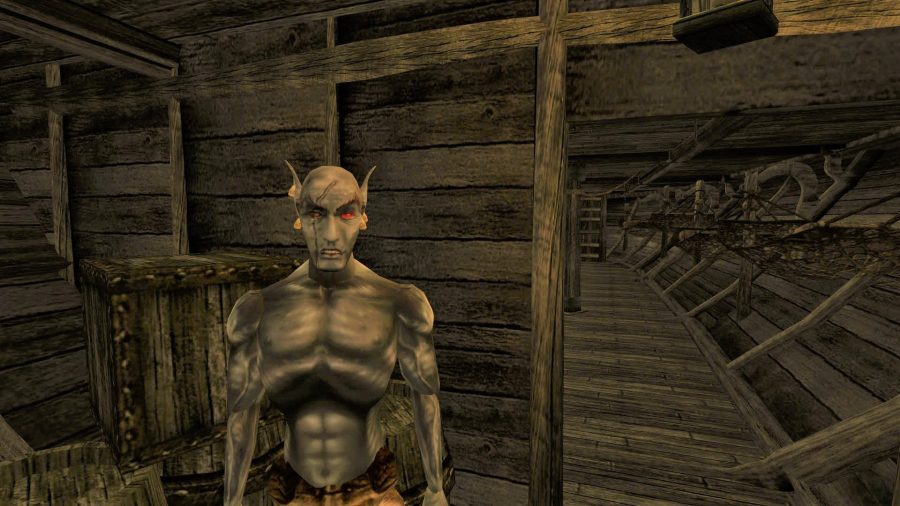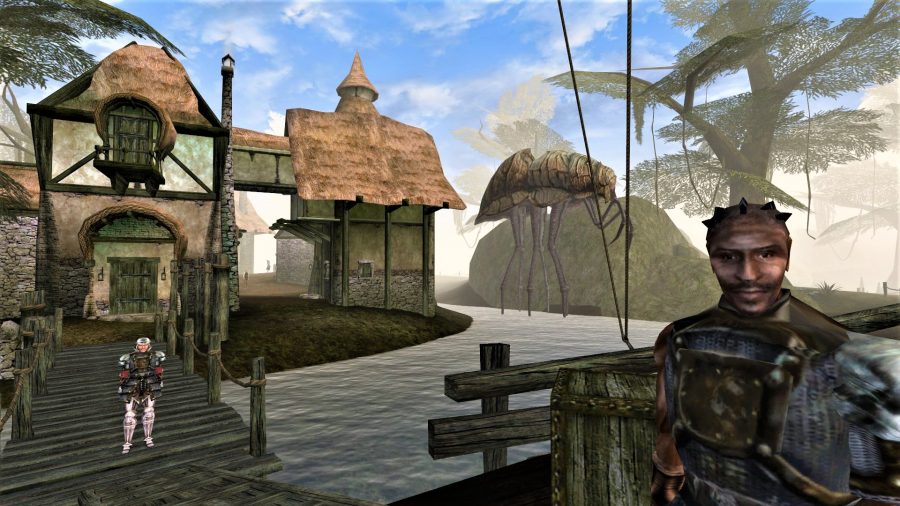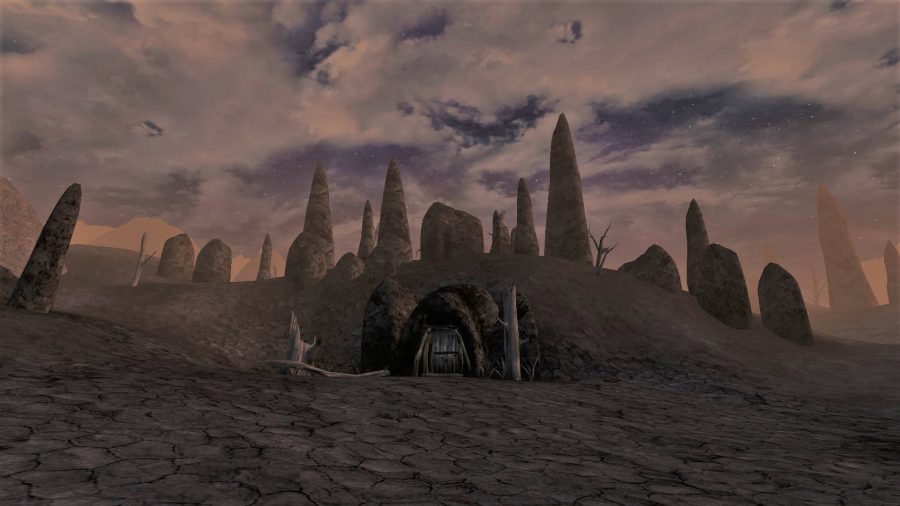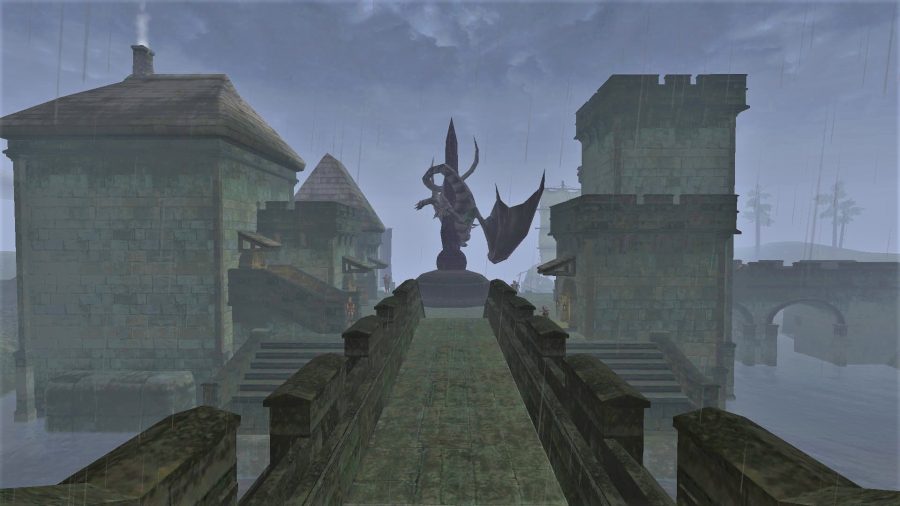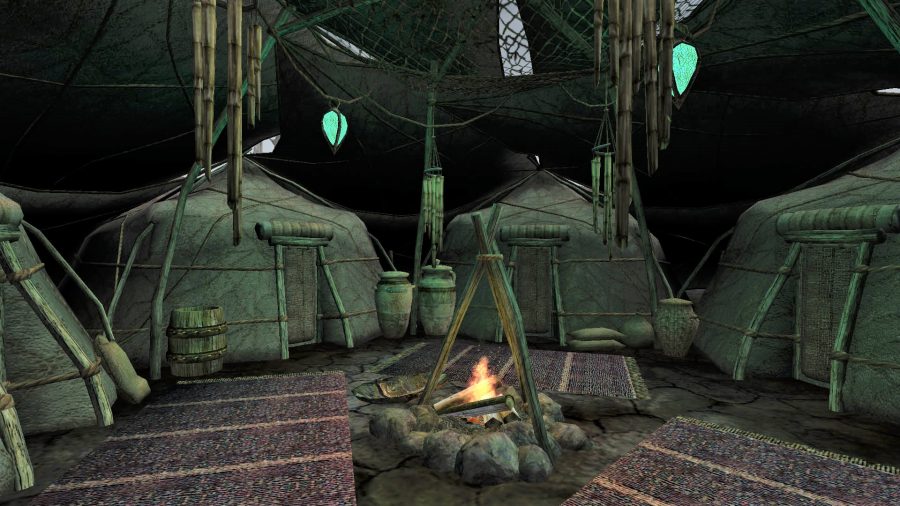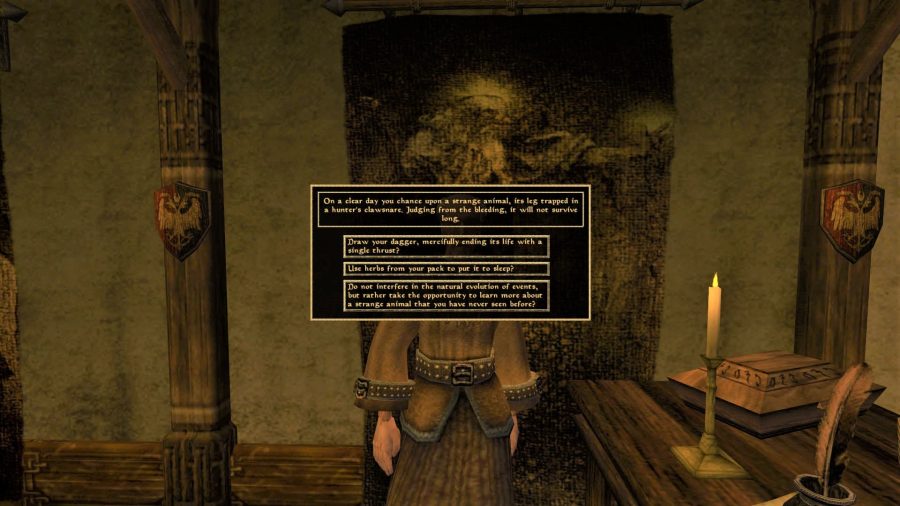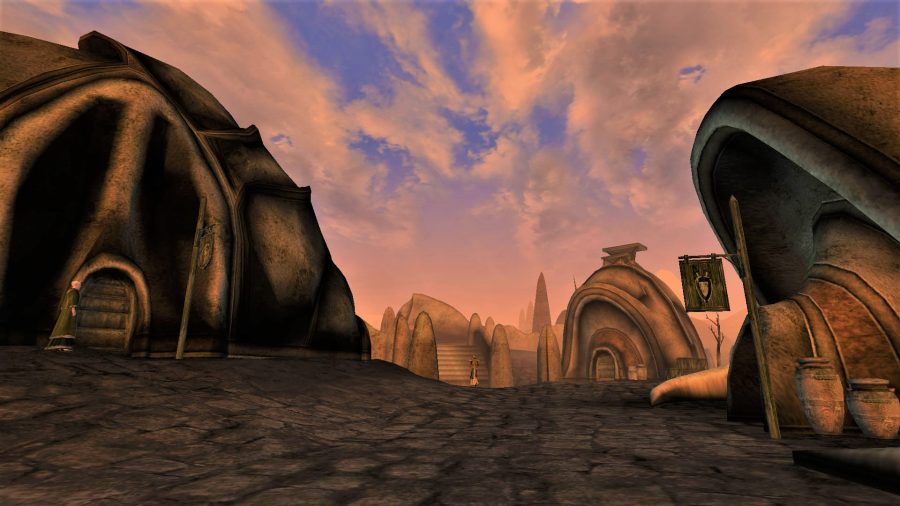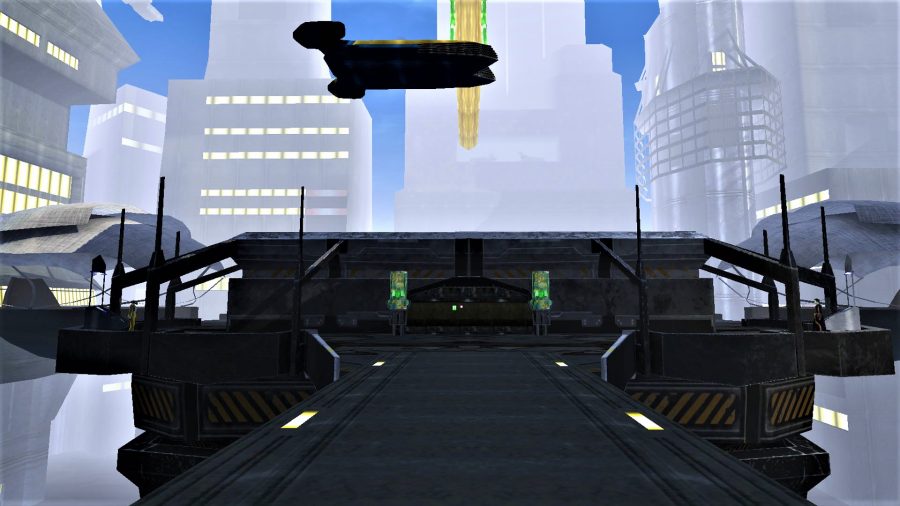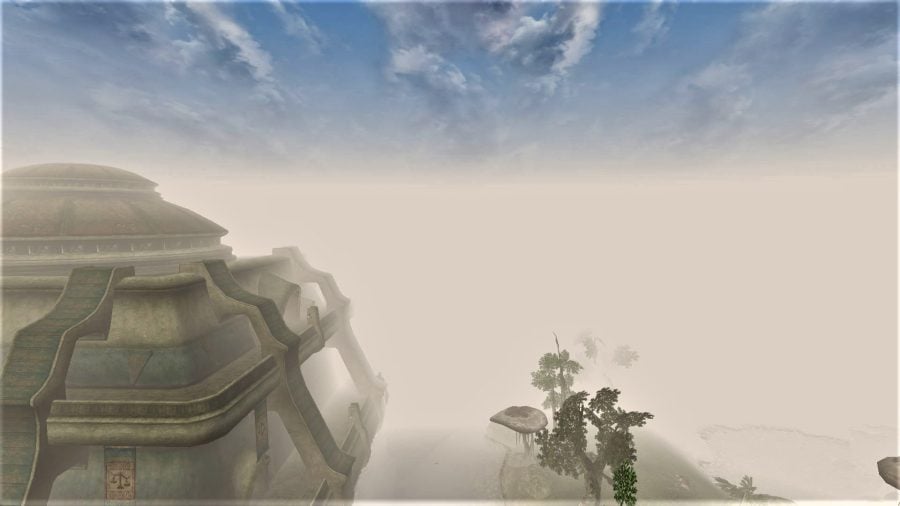Videogame RPGs and tabletop RPGs have a long history of being intrinsically intertwined. Sometimes this can be in the form of direct conversions, such as the many Dungeons & Dragons videogames that have been created over the years. In other cases, it can be through inspiration, as with the Fallout series – which was created in the GURPS TTRPG setting before becoming a standalone videogame.
Sometimes, however, tabletop RPG DNA can be baked into every aspect of a videogame. The Elder Scrolls 3: Morrowind, the third main-line Elder Scrolls game, is the perfect example of this. Whilst it is unashamedly a videogame and takes advantage of its medium perfectly, it’s clear this is a game very much in love with tabletop RPGs.
Many videogame RPGs display their tabletop inspirations on their sleeves, but Morrowind manages to be something completely of its format whilst still embracing tabletop roots in almost every aspect of its being. With the 20th anniversary fast approaching, we thought it was the perfect time to take a closer look at The Elder Scrolls III: Morrowind – and rip it apart to see the TTRPG heart beating under its 2002-era graphics.
We’ll start where all the best adventures begin – in a boat, with a topless elf staring at you, and no further information.
Wake up, we’re here
Beginning a new adventure in Morrowind is instantly familiar to anyone who’s ever played a tabletop RPG. You receive a blank character sheet, within whose emptiness is the potential of all your adventures. Will you be a mage, a warrior, a thief? Those are the basic archetypes, but – just like DnD – you can create characters that embody roles, histories, and play styles that are unique to yourself.
In Morrowind, you play a role you create, not one handed to you
The D&D-like breadth of Morrowind’s character creator cannot be understated. From Orcish dual-wielding Barbarians to Elven ranged expert Rangers, there’s a huge amount of leeway in how you make your character and most builds can become viable. Should you wish to make your hero an unarmed Monk or a spell-tossing Wizard, the choice is absolutely yours. Though – to step into game guide territory for just a moment – if this is your first time playing Morrowind, please stay away from the spellcasters. At least until you understand the systems a little better.
What truly places Morrowind’s character creator into the realm of tabletop RPGs, however, isn’t the selection of race, skills, and various inherent buffs – it’s how this can reflect the role you want to play in this world. Morrowind isn’t satisfied with giving you a character, you have a true blank slate that you can fill out in whatever way best suits you.
There are only two constants in Morrowind: you start as a prisoner and you were born ‘under a certain sign’. The former you can explore in your backstory however you choose, the latter is simply a circumstance of birth, and can play as much or little into your character creation as you so wish. In Morrowind, as in TTRPGs, you are playing a role you create – not one that is handed to you.
Shared stories: These are the best tabletop RPGs out there
Now, imagine your first game of a tabletop RPG. You don’t know the classes, you don’t know the systems, you don’t know anything about your upcoming adventure. Your friendly game master can help guide you to create your first character – and, like a kindly face peeking over a screen, Morrowind gives you the same option. Instead of choosing a class or building your own, you can simply answer a series of questions that focus on who your character is. This results in a class selection you can try out, giving you a very human way of introducing yourself to its systems.
From there, it’s time to head out into the wide world. Speaking of heading out…
Stepping off the beaten path
Many videogames, especially RPGs, give you a golden path to follow that leads from your first step to the end credits. Morrowind sets itself apart here, firmly rooting itself in the more freeform, anything-goes world of tabletop RPGs. The world map is big, empty, foreign, and stubbornly bereft of helpful pins or quest markers.
You start the game as a literal nobody
Not long after arriving on the island of Vvardenfell, you receive your first taste of the main quest. You are to deliver a package to a man named Caius Cosades in the city of Balmora, far to the north. After a long schlep filled with many rats, bandits, and creatures both surprising and horrible, you arrive in its adobe-constructed streets. You hand your charge over to this grumpy, half-naked man and…
He tells you to piss off.
You see, on the island of Vvardenfell, and to Cosades himself, you’re a nobody. Fresh off the boat, prisoners’ shackles still leaving a mark on your flesh. Who are you to be entrusted with his mission? No, it’s time to go away. Level up. Become stronger. Earn influence with the factions that dot the island, then you can return and talk about your fate on this small volcanic isle.
The idea here – an idea you can tell has come directly from tabletop RPGs – is to encourage you to have an adventure. You aren’t ticking off a series of checkboxes given to you by a computer or a designer sitting in a far-off room; you’re encouraged to become something more. It’s very much about the journey – a journey that will be unique to you, your character, and your playstyle.
Different strokes: Read our complete guide to DnD classes
The game gives you a frankly startling amount of choice here, it’s understandable if many become overwhelmed. You can visit anywhere, join myriad guilds and groups, earn favour with Great Houses. It’s up to you. Many of those options will also lock out other options, meaning you can only do a certain amount of them.
Compare this to a Dungeons & Dragons adventure. Whilst your erstwhile GM may be trying to keep you on a path, you are free to do almost anything you can think of. Kill that NPC, steal from that shop, decide ‘nuts to this’ and walk out of a dungeon. In Morrowind you are granted that same freedom, a freedom that doesn’t come with beads of sweat pouring down your game master’s forehead as they try to keep up with your wild ideas.
You make the decisions – and reap the results
Morrowind, like tabletop RPGs, encourages you to have an original experience. Something you can then recount to your friends. It’s about telling a story with you at the centre, instead of providing you with an identikit adventure, matching that of every other player. You make the decisions and you reap the consequences. It all ties into Morrowind being, more than so many other RPG videogames before and since, a fundamentally organic experience that can be shaped by you.
A human adventure
The main draw of tabletop RPGs, other than falling in love with their systems, is that they’re all about the human touch. You’ll probably experience a pre-written story, but it’ll be performed by a game master, interpreted for your specific group, and influenced by your decisions. Some of your game master’s NPCs will be helpful, some may be stupid, others outright hostile. The main point is that they’re being performed by a human, with all that entails.
Videogames often lack that human touch. Morrowind, however, has a shockingly good stab at replicating it, mainly in the way that you interact with its colossal roster of non player characters.
Worldshaper: Read our ultimate guide to DnD maps
Morrowind is set on a large island filled with NPCs, many of whom will have quests or directions for you. In grand tabletop RPG tradition, however, these NPCs can be fallible, stupid, greedy, or antagonistic. Unlike many videogames, you don’t get what you want straight away. Even if you do get the directions you’ve been looking for, they may be imprecise, at best, or outright wrong at worst.
For example, take a look at the quest ‘Beneran’s Bounty’. You’re handed this in the city of Ald’ruhn and told to head to the dungeon of Sargon, north of the town of Maar Gan. That’s pretty much all the info you get. You don’t know where the dungeon is, nor do you have any direction other than ‘north’.
Some may set out, trudging north from Maar Gan, searching for Sargon in every nook and cranny. The game, however, has a trick up its sleeve. Sargon is indeed north of Maar Gan – but it’s so far north it might as well be in another nation, tucked away on an island in the Sea of Ghosts. Your quest-giver gave you faulty instructions.
Other games give you quest markers – Morrowind makes you work it out
This can be frustrating, sure, but a little questioning in Maar Gan can see you put on the right path. Another game may hand you a GPS quest marker, or at least a precise map location, but Morrowind doesn’t – and nor does Dungeons and Dragons. Navigating these adventures is all about exploration, about asking the right questions, about taking notes, and about navigating how people work.
Morrowind is an organic adventure set in a digital world, making it something very special in the annals of videogame history.
Many worlds are possible
Playing DnD isn’t like playing a videogame in one key, crucial factor. Videogames tell a story, or give you an adventure – but once it’s over, it’s over. Tabletop RPGs, especially established RPGs like Dungeons & Dragons, are more a sandbox allowing you to create and tell your own stories – using the game’s systems as a starting point.
Morrowind, more than anything else, is one of those rare videogames that allows you to do just this. With the release of this third Elder Scrolls game, Bethesda also released their own Creation Kit, the very digital tools they used to make the game in the first place.
Sense of place: Read our guide to the best DnD settings
These allow players to build their own adventures in the Morrowind engine, letting modders twist and change the entire game to be almost unrecognisable, if you so wish. If you have completed Morrowind and simply want more, then there’s tons of extra content now available (for free) on the internet. If you want to change how the game plays, then there’s plenty of extra mods that let you alter almost every aspect of the game. Even if you just want it to look different, that’s catered for too.
The whole game, especially 20 years after release, can be a sandbox for custom adventures, stories, and systems that are completely different from anything the creators originally intended. Much like Dungeons & Dragons’ ability to be changed by the players – not only adding new adventures but also adding custom homebrew DnD rules – in Morrowind, if you can imagine it, there’s probably a mod for it. If there isn’t, then you can grab the Creation Kit in your Morrowind installation directory and learn to make it yourself.
Morrowind, like the tabletop RPGs that serve as its inspiration, is a brilliant example of the potential of videogames and how close they can come to replicating the tabletop RPG experience. This third Elder Scrolls game gives the player a huge amount of choice, from character creation to how you play the game, from engaging with its bevy of truculent NPCs to building your own quests.
It’s these reasons, amongst many other small touches that help bring the game to life, that help define Morrowind as not only a great videogame, but also a Dungeons and Dragons-style TTRPG in videogame form. It’s messy, it’s complicated, it’s often obtuse and confusing. Just like all good tabletop RPGs. And we wouldn’t change a damn thing about either.
Source: Wargamer




